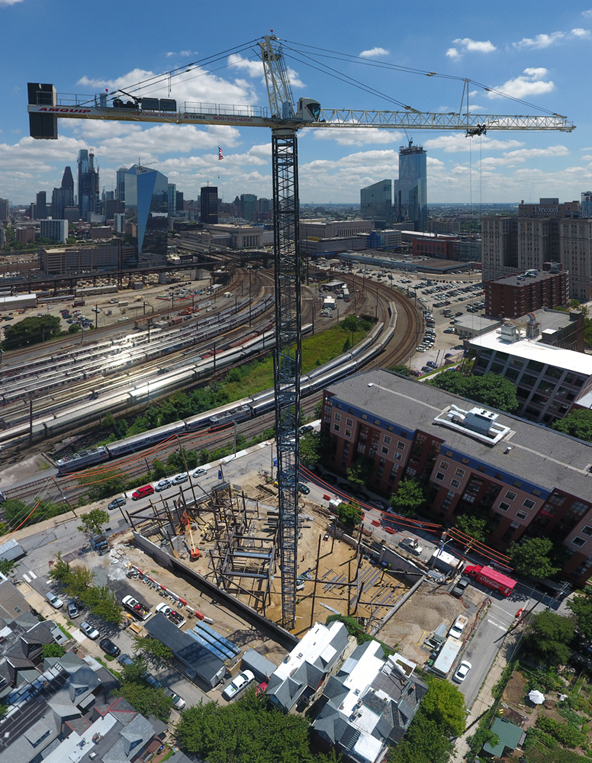An economic boom in the University City area of Philadelphia brings job growth and real estate development. (Photo courtesy of Radnor Property Group)
The new face of 21st-century prosperity emerges outside a second floor window at 38th and Market Streets in the University City area of Philadelphia. Construction cranes mark a skyline proliferating with new health care facilities and technology accelerators, symbolic of a recent $5 billion building boom within a single square mile. Vacant lots stand ready for a new wave of development, which will add a planned 10 million square feet of real estate and shift Philadelphia’s downtown westward over the next decade.
On the other side of the window, a different sort of transformation takes hold—this time on a human scale. Twenty-five unemployed men and women sit around a U-shaped table, listening in rapt attention as a facilitator prepares them for successful launch into the workforce. They are the latest participants in the West Philadelphia Skills Initiative (WPSI), started six years ago by the organization I run, University City District, with a mission to connect large employers seeking entry-level talent with unemployed community members seeking work. WPSI responds to a palpable opportunity divide: In eight square blocks in Philadelphia, the acceleration of economic activity is unrivaled in all but a few places in the United States, while in the five neighboring zip codes, one-third of the population lives in poverty.
There are windows like the one at 38th and Market across the United States. The geography of urban prosperity very often transects swaths of economic disconnection. But talent is everywhere, equally distributed in all directions. How we bridge the gulf between economic growth on one side of the window and human potential on the other will determine whether “inclusive prosperity”—economic expansion that produces jobs and opportunities for social mobility among the unemployed and underemployed—is simply a term du jour or an actionable strategy for creating pathways into the middle class.
In past economic booms, sweeping federal action took aim at ensuring that the fruits of prosperity would be widespread, beyond mere redistribution of income; the GI Bill and elements of the New Deal, for example, devoted federal government resources to ensuring that a broad range of workers got a share of the economic pie. But the current era of federal restraint seems unlikely to yield grand policy breakthroughs shaping equitable growth. And structural changes—including globalization, automation, shifting labor markets, and a yawning skills gap—stand in the way of macroeconomic progress capable of transforming opportunity at the neighborhood level.
Equitable growth is therefore less likely to occur as a result of a far-reaching strategy than as the product of tactical expertise and sustained commitment among business and civic actors. It is therefore prudent for us to ground inclusive growth efforts locally, where webs of trusted partnerships and working relationships are established.
Inclusive prosperity in 2017 is an all-hands-on-deck, roll-up-your-shirtsleeves effort in communities, but a new era of local action need not diminish aspirations. At our West Philadelphia Skills Initiative, program graduates who had been unemployed an average of 54 weeks have now earned—in the aggregate—more than $14 million in wages, typically in jobs that offer full benefits and advancement possibilities. Last year, 95 percent of graduates found employment, with most retaining their jobs far longer than the average hire.
Career opportunities for the long-term unemployed in our community and many others include front-line hospital positions, lab technician jobs, and administrative support work. In some cases, direct hiring by large employers is not possible because of a candidate’s skills mismatch or criminal history, so we’ve started to explore different solutions. We’ve begun thinking about how to leverage $3 billion in annual procurement of goods and services among local anchor institutions to create business opportunities, such as launching a landscaping firm that hires harder-to-place workers at nearly twice the minimum wage with exemplary benefits and year-round employment.
Philadelphia is not alone. In Cleveland, anchor institutions and philanthropists—with the aim of creating wealth at scale for the working poor—have ambitiously seeded employee-owned businesses using local purchasing power. In Milwaukee, employers and labor unions have partnered to launch hundreds of construction careers within previously disconnected neighborhoods.
How do these local efforts succeed? Often, it is because the following three foundational principles coalesce:
- Build on existing platforms. For example, WPSI did not result from the invention of a new workforce agency. University City District, its parent, is a business improvement district, a vehicle through which major property owners join forces to fund and implement physical transformation—clean and safe streets, active and vibrant public spaces. We leveraged local trust and partnerships to focus on economic opportunity at scale. Instead of reinventing the wheel, communities around the country should ask themselves: Where do employers already come together? What groups already convene business leaders and engender trust? How do we embed inclusive prosperity into these partnerships?
- Largess doesn’t scale. Results do. The road to dead-end partnerships with industry begins by asking employers to take a chance on hiring local residents for the common good. The enduring path to equitable growth is to develop a deep understanding of employer needs and pain points, and to co-design training curricula and recruitment strategies. One employer partner of WPSI, for example, transformed a 50 percent turnover rate for medical assistants into a 92 percent retention rate. Solving real business needs means we can grow this work at scale; success means we can embed inclusion into the operating mantra of local employers who see us as partners in human resource solutions, not just “charity.”
- Place matters. Equity strategies like workforce development are often proposed on a citywide or regional scale. But neighborhood-level action holds special promise. Putting people to work a short commute from where they live overcomes innumerable barriers and increases the likelihood of a committed, punctual employee. The virtuous cycle of neighbor after neighbor connecting to employment, and spreading the word to their friends and family accelerates change. Similarly, businesses and institutions that plan and invest together in the physical health of a particular community can pivot to co-invest in human capital and community wealth. They can see the businesses from which they buy and can touch neighborhoods from which they hire.
In our neighborhood and in a growing cohort of communities, economic opportunity is woven into the DNA of economic growth. Every new lab building that rises from fallow land drives demand for local lab technicians. Every new public space provides opportunity for newly minted landscapers. Every medical office transforms the career trajectories of people who never thought they could be valuable to their employer. Neighborhoods like ours—equal parts economic growth and despair—do not need to wait for edict or external forces to bridge the opportunity divide. Instead, we can forge inclusive prosperity every day at ground level, prompted by local partners who demand an economy that works for all, and inspired by talented community members who want to traverse an emerging path to the middle class.





